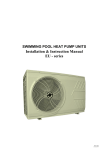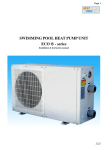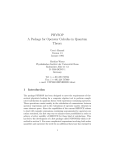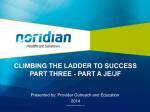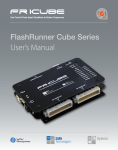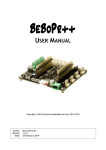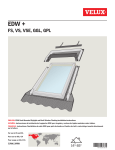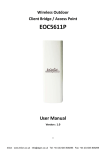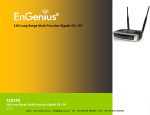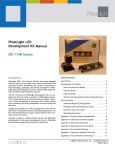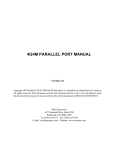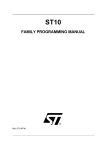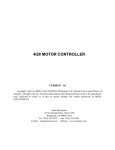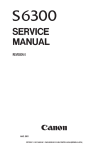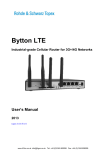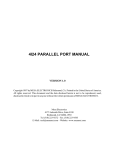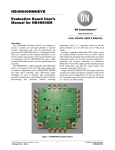Download 4I30 QUADRATURE COUNTER MANUAL
Transcript
4I30 QUADRATURE COUNTER MANUAL VERSION 1.2 Copyright 2004 by MESA ELECTRONICS Richmond, CA. Printed in the United States of America. All rights reserved. This document and the data disclosed herein is not to be reproduced, used, disclosed in whole or in part to anyone without the written permission of MESA ELECTRONICS. nm Mesa Electronics 4175 Lakeside Drive, Suite #100 Richmond, CA 94806-1950 Tel (510) 223-9272 - Fax (510) 223-9585 E-Mail: [email protected] - Website: www.mesanet.com 4I30 USER'S MANUAL 4I30 USER'S MANUAL TABLE OF CONTENTS HANDLING PRECAUTIONS Handling precautions . . . . . . . . . . . . . . . . . . . . . . . . . . . . . . . . . . . . . . . . . . . . . . . . . . . . . . . . . . . . . . . . . . 5 INTRODUCTION General . . . . . . . . . . . . . . . . . . . . . . . . . . . . . . . . . . . . . . . . . . . . . . . . . . . . . . . . . . . . . . . . . . . . . . . . . . . . . . . . 7 CONFIGURATION General . . . . . . . . . . . . . . . . . . . . . . . . . . . . . . . . . . . . . . . . . . . . . . . . . . . . . . . . . . . . . . . . . . . . . . . . . . . . . . . . 8 Default configuration . . . . . . . . . . . . . . . . . . . . . . . . . . . . . . . . . . . . . . . . . . . . . . . . . . . . . . . . . . . . . . . . . . 8 Base address select . . . . . . . . . . . . . . . . . . . . . . . . . . . . . . . . . . . . . . . . . . . . . . . . . . . . . . . . . . . . . . . . . . . 10 Input level select . . . . . . . . . . . . . . . . . . . . . . . . . . . . . . . . . . . . . . . . . . . . . . . . . . . . . . . . . . . . . . . . . . . . . . 10 Timer mode . . . . . . . . . . . . . . . . . . . . . . . . . . . . . . . . . . . . . . . . . . . . . . . . . . . . . . . . . . . . . . . . . . . . . . . . . . . 10 Index polarity . . . . . . . . . . . . . . . . . . . . . . . . . . . . . . . . . . . . . . . . . . . . . . . . . . . . . . . . . . . . . . . . . . . . . . . . . 10 RS-422 termination . . . . . . . . . . . . . . . . . . . . . . . . . . . . . . . . . . . . . . . . . . . . . . . . . . . . . . . . . . . . . . . . . . . 10 Counter size option . . . . . . . . . . . . . . . . . . . . . . . . . . . . . . . . . . . . . . . . . . . . . . . . . . . . . . . . . . . . . . . . . . . 10 INSTALLATION General . . . . . . . . . . . . . . . . . . . . . . . . . . . . . . . . . . . . . . . . . . . . . . . . . . . . . . . . . . . . . . . . . . . . . . . . . . . . . . . 11 I/O connector orientation . . . . . . . . . . . . . . . . . . . . . . . . . . . . . . . . . . . . . . . . . . . . . . . . . . . . . . . . . . . . . 11 OPERATION Connector pinout . . . . . . . . . . . . . . . . . . . . . . . . . . . . . . . . . . . . . . . . . . . . . . . . . . . . . . . . . . . . . . . . . . . . . 12 Encoder power . . . . . . . . . . . . . . . . . . . . . . . . . . . . . . . . . . . . . . . . . . . . . . . . . . . . . . . . . . . . . . . . . . . . . . . . 13 Connecting TTL encoders . . . . . . . . . . . . . . . . . . . . . . . . . . . . . . . . . . . . . . . . . . . . . . . . . . . . . . . . . . . . 13 Connecting open collector encoders . . . . . . . . . . . . . . . . . . . . . . . . . . . . . . . . . . . . . . . . . . . . . . . . . . 13 Connecting RS-422 encoders . . . . . . . . . . . . . . . . . . . . . . . . . . . . . . . . . . . . . . . . . . . . . . . . . . . . . . . . . 13 Encoder direction . . . . . . . . . . . . . . . . . . . . . . . . . . . . . . . . . . . . . . . . . . . . . . . . . . . . . . . . . . . . . . . . . . . . . 13 Register map . . . . . . . . . . . . . . . . . . . . . . . . . . . . . . . . . . . . . . . . . . . . . . . . . . . . . . . . . . . . . . . . . . . . . . . . . . 14 Command register . . . . . . . . . . . . . . . . . . . . . . . . . . . . . . . . . . . . . . . . . . . . . . . . . . . . . . . . . . . . . . . . . . . . 14 4I30 commands . . . . . . . . . . . . . . . . . . . . . . . . . . . . . . . . . . . . . . . . . . . . . . . . . . . . . . . . . . . . . . . . . . . . . . . 15 Busy bit . . . . . . . . . . . . . . . . . . . . . . . . . . . . . . . . . . . . . . . . . . . . . . . . . . . . . . . . . . . . . . . . . . . . . . . . . . . . . . . 15 Reading a counter . . . . . . . . . . . . . . . . . . . . . . . . . . . . . . . . . . . . . . . . . . . . . . . . . . . . . . . . . . . . . . . . . . . . . 15 Index operation . . . . . . . . . . . . . . . . . . . . . . . . . . . . . . . . . . . . . . . . . . . . . . . . . . . . . . . . . . . . . . . . . . . . . . . 15 Enable register . . . . . . . . . . . . . . . . . . . . . . . . . . . . . . . . . . . . . . . . . . . . . . . . . . . . . . . . . . . . . . . . . . . . . . . . 16 Index register . . . . . . . . . . . . . . . . . . . . . . . . . . . . . . . . . . . . . . . . . . . . . . . . . . . . . . . . . . . . . . . . . . . . . . . . . 16 Using the index inputs . . . . . . . . . . . . . . . . . . . . . . . . . . . . . . . . . . . . . . . . . . . . . . . . . . . . . . . . . . . . . . . . 17 A fine point . . . . . . . . . . . . . . . . . . . . . . . . . . . . . . . . . . . . . . . . . . . . . . . . . . . . . . . . . . . . . . . . . . . . . . . . . . . 17 Timing reference . . . . . . . . . . . . . . . . . . . . . . . . . . . . . . . . . . . . . . . . . . . . . . . . . . . . . . . . . . . . . . . . . . . . . 17 Maximum count rate . . . . . . . . . . . . . . . . . . . . . . . . . . . . . . . . . . . . . . . . . . . . . . . . . . . . . . . . . . . . . . . . . . 17 4I30 USER'S MANUAL TABLE OF CONTENTS REFERENCE INFORMATION Specifications . . . . . . . . . . . . . . . . . . . . . . . . . . . . . . . . . . . . . . . . . . . . . . . . . . . . . . . . . . . . . . . . . . . . . . . . 18 Warranty . . . . . . . . . . . . . . . . . . . . . . . . . . . . . . . . . . . . . . . . . . . . . . . . . . . . . . . . . . . . . . . . . . . . . . . . . . . . . 19 Schematic diagrams . . . . . . . . . . . . . . . . . . . . . . . . . . . . . . . . . . . . . . . . . . . . . . . . . . . . . . . . . . . . . . . . . . 21 Page 4 4I30 USER'S MANUAL HANDLING PRECAUTIONS STATIC ELECTRICITY The CMOS integrated circuits on the 4I30 can be damaged by exposure to electrostatic discharges. The following precautions should be taken when handling the 4I30 to prevent possible damage. A. Leave the 4I30 in its antistatic bag until needed. B. All work should be performed at an antistatic workstation. C. Ground equipment into which 4I30 will be installed. D. Ground handling personnel with conductive bracelet through 1 megohm resistor to ground E. Avoid wearing synthetic fabrics, particularly Nylon. Page 5 4I30 USER'S MANUAL Page 6 4I30 USER'S MANUAL INTRODUCTION GENERAL The MESA 4I30 is a stackable PC/104 card with four 32 bit up/down counters with quadrature count inputs and per channel index inputs. The 4I30 is intended for robotic, motor control, measurement, and instrumentation applications. The 4I30 has selectable TTL or RS-422 levels on its quadrature and index inputs. TTL or RS-422 operation is jumper selectable in groups of two channels. The TTL inputs have pullup resistors and RC / Schmitt filtering. The differential RS-422 inputs are suited for longer cable lengths and have optional termination. Each time a logic transition occurs at one of the quadrature inputs, the count is incremented or decremented, providing a resolution of four times the line count of the encoder used. The 4I30 counters may cleared individually, or all counters may be cleared simultaneously. Each counter has a separate programmable count enable/disable with external index input. The 4I30 can be programmed so that the count is synchronized with the external index signal. Index signal polarity is jumper selectable. Maximum count rate of the 4I30 is 1.5 million counts per second. Count range is -214748368 to +214748367 or 0 to 4,294,967,295. One counter may be configured to provide a timing reference for velocity calculations instead of quadrature input. This timing reference is a 32 bit up counter running at 500 KHz +- .01%. The 4I30 uses a 50 pin header for I/O connections. The encoder inputs are arranged in groups of 10 pins per encoder. Each 10 pin group includes power and multiple grounds. 5V power on the I/O connectors is fused on the 4I30. All 4I30 models can use the 16 bit stack through type PC/104 bus architecture. Four layer circuit card construction is used to minimize radiated EMI and provide optimum ground and power integrity. The 4I30 requires only +5V for operation The 4I30 base address is set with jumpers, and can be located at four separate I/O locations within the 1024 byte I/O address space of the PC/104 bus. Up to four 4I30 cards may be used in a system. Page 7 4I30 USER'S MANUAL CONFIGURATION GENERAL The 4I30 port address and various other options are set with jumpers. Each group of jumpers will be discussed separately by function. In the following discussions, when the words "up", "down", "right", and "left" are used it is assumed that the 4I30 I/O card is oriented with its bus connectors J1 and J2 at the bottom edge of the card (nearest the person doing the configuration). DEFAULT JUMPER SETTINGS Factory default 4I30 jumpering is as follows: FUNCTION JUMPER(S) SETTING 4I30 Base address W5,W6 up ,down - 0210H Input type W1,W3 right, right -TTL type inputs Chan 3 timer option W2 right - Not enabled Index polarity W7 right - Active low Clock option W4 right - Not implemented Page 8 4I30 USER'S MANUAL CONFIGURATION DEFAULT JUMPER SETTINGS Page 9 4I30 USER'S MANUAL CONFIGURATION BASE ADDRESS SELECTION The base I/O address of the 4I30 is selected by placing shorting jumpers on jumper blocks W5 and W6. Jumper blocks W5 and W6 have three pins and two valid shorting jumper locations, up, and down. The following table shows the base address settings: BASE ADDRESS 0200H 0208H 0210H (Default) 0218H W5 down down up up W6 down up down up INPUT LEVEL SELECTION Jumpers W1 and W3 select TTL or RS-422 levels on the quadrature and index inputs. W1 selects the input option for channels 2 and 3 while W3 selects the input option for channels 0 and 1. When W1 or W3 are in the right hand position, TTL input levels are selected. When W1 or W3 are in the left hand position, RS-422 levels are selected. Input levels for counter pairs 0-1 and 2-3 can be selected independently, allowing a mix of encoder types. TIMER OPTION To facilitate velocity calculations, counter 3 may be configured to provide a timing reference instead of quadrature input. This timing reference is a 32 bit up counter running at 500 KHz +- .01%. To select this timing reference W2 is placed in the left hand position. If W2 is placed in the right hand position, counter 3 functions as a the quadrature counter. INDEX POLARITY SELECTION Polarity of the index signals are selected by W7. When W7 is in the right hand position index levels are active low. When W7 is in the left hand position index levels are active high. RS-422 TERMINATION The RS-422 differential inputs are normally always terminated. If termination is not desired resistor networks RN3, RN7, and RN11 may be unplugged. COUNTER SIZE OPTION The counter word size option is not yet implemented and W4 must be placed in the right hand position. Page 10 4I30 USER'S MANUAL INSTALLATION GENERAL When the 4I30 has been properly configured for its application, it can be inserted into a PC/104 stack. The standoffs should then be tightened to secure the 4I30 in its place. When the 4I30 is secured in the stack the I/O connectors can be plugged in from the side. I/O CONNECTOR ORIENTATION The 50 pin connector on the 4I30 have their pin one ends marked with a white square on the circuit card. This is at the bottom (near the PC/104 connectors). (Note: Some early cards have pin one mismarked. See page 7 for correct location). This corresponds with the red stripe on typical flat cable assemblies. If more positive polarization is desired, center polarized IDC header connectors should be used. These connectors will not fully mate with the pins on the 4I30 if installed backwards. A suggested center polarized 50 pin IDC header is AMP PN 1-746285-0. The connections to each encoder is a group of 10 pins. These 10 pin groups can be split off from the 50 conductor flat cable and individually terminated with 10 pin headers. Page 11 4I30 USER'S MANUAL OPERATION CONNECTOR PIN-OUT The 4I30 50 pin I/O connector pinout is as follows: P1 CONNECTOR PIN SIGNAL PIN SIGNAL 1 3 5 7 9 ENCA0 GND /ENCB0 IDX0 GND 2 4 6 8 10 /ENCA0 ENCB0 GND /IDX0 +5V Fused power 11 13 15 17 19 ENCA1 GND /ENCB1 IDX1 GND 12 14 16 18 20 /ENCA1 ENCB1 GND /IDX1 +5V Fused power 21 23 25 27 29 ENCA2 GND /ENCB2 IDX2 GND 22 24 26 28 30 /ENCA2 ENCB2 GND /IDX2 +5V Fused power 31 33 35 37 39 ENCA3 GND /ENCB3 IDX3 GND 32 34 36 38 40 /ENCA3 ENCB3 GND /IDX3 +5V Fused power 41 43 45 47 49 GND GND GND +5V Fused power +5V Fused power 42 44 46 48 50 GND GND +5V Fused power +5V Fused power +5V Fused power Page 12 4I30 USER'S MANUAL OPERATION ENCODER POWER The 4I30 can supply +5V to power external encoders or other external devices. If these external devices are powered remotely do not connect to the +5V on the 4I30. +5V power on the 4I30 is fused. Note that the +5V fuse is rated at 1 Amp and can be replaced without soldering. Replacement part number is LittleFuse PN 250001. CONNECTING TTL ENCODERS When using TTL output encoders, select the TTL input type for the counter using W1 and W3. Connect the "A" output of the encoder to /ENCAn, the "B" output to /ENCBn, and the "I" output to /IDXn (where n is the counter number). As an alternative, if the terminator resistors are installed (RN3, RN7, RN11), the active high input can also be used. Nominal input filter time constant on the 4I30 TTL inputs is 220 nS. If it is desired to increase the R/C time constant, a higher value of terminator resistor can be substituted. CONNECTING OPEN COLLECTOR ENCODERS When using open collector output encoders connect for TTL input as above. A 3.3K pullup resistor is provided. If this value is not suitable the resistor networks RN4 and RN8 may be replaced with an appropriate value. RN8 is the pullup for channel 0 and 1, RN4 is the pullup for channels 2 and 3. The pullup resistor networks are 10 pin SIP's 9 resistor with pin 1 common. Pin one points down. CONNECTING RS-422 ENCODERS When using RS-422 output encoders select the RS-422 input type for the counter using W1 and W3. Connect the "\A" output of the encoder to /ENCAx, the "A" output of the encoder to ENCAx, the "/B" output to /ENCBx", the B",output to ENCBx, the "/I" output to /IDXx, and the "/I" output to /IDXx (where x is the counter number). If termination is not desired remove RN3, RN7, and RN11. ENCODER DIRECTION If it is desired to reverse the count direction on a particular channel, interchange the A and B signals. Page 13 4I30 USER'S MANUAL OPERATION REGISTER MAP The I/O registers on the 4I30 occupies 8 contiguous bytes. These 8 bytes start at the I/O address set by jumpers W5 and W6. ADDRESS READ DATA WRITE DATA BASE +0 BASE +1 BASE +2 BASE +3 BASE +4 BASE +5 BASE +6 BASE +7 Latched counter bits [0..7] Latched counter bits [8..15] Latched counter bits [16..23] Latched counter bits [24..31] Enable register Index register Enable register Index register XXXXXXXX XXXXXXXX XXXXXXXX XXXXXXXX Enable register XXXXXXXX Command register XXXXXXXX COMMAND REGISTER All access to the 4I30 counters is done by first writing a command byte to the command register. The command register is located at the 4I30 base address + 6. When the command byte is written, the busy bit is set, indicating that the command is being executed. This applies to all clear and read counter commands. When the busy bit is clear, the operation is complete. The typical time to complete a command is 3 uS. The maximum time is 4 uS. After issuing a command, interface software can poll the busy bit to determine when the requested operation is complete, or wait 4 uS after the command before issuing another command or reading a counter. Commands that access individual counters specify the counter with the 2 least significant bits of the command register. COMMAND REGISTER BIT 7 BIT 6 BIT 5 BIT 4 BIT 3 BIT 2 BIT 1 BIT 0 BSY XXX LED CLRA CLR READ SEL1 SEL0 Page 14 4I30 USER'S MANUAL OPERATION 4I30 COMMANDS These are the valid command bytes in hex: COMMAND READ COUNTER 0 READ COUNTER 1 READ COUNTER 2 READ COUNTER 3 CLEAR COUNTER 0 CLEAR COUNTER 1 CLEAR COUNTER 2 CLEAR COUNTER 3 CLEAR ALL LED ON LED OFF COMMAND BYTE 84H 85H 86H 87H 88H 89H 8AH 8BH 90H 20H 00H BUSY BIT Once a command is written, interface software can poll the busy bit in the status register to determine when the command is complete. The busy bit is bit 7 at register offsets 4,5,6 and 7. All commands that have the BSY bit set take between 2 and 4 uS to complete. READING A COUNTER The sequence of events for reading counter 0 is as follows: 1. Issue the READ COUNTER 0 command 2. Wait for busy bit to be clear 3. Read latched counter data (Write 84H to 4I30 address +6) ( Poll bit 7 of 4I30 address +6 until low) ( Read bytes from 4I30 address +0,+1,+2, +3) Successive bytes of the 32 bit count value are located at successive I/O locations. This makes it possible to read the counter as four individual bytes, two 16 bit words, or a single 32 bit value (386 processors and above) using four, two, or a single input instruction. When reading counters, the latched data will remain valid until the next read counter command is issued. Page 15 4I30 USER'S MANUAL OPERATION INDEX OPERATION It is possible to synchronize each counter on the 4I30 with an external index input. Each counter channel has an associated count enable bit. These bits can be set and cleared by software, and set by the external index inputs. By initially clearing an enable bit, and clearing the associated counter, the counter is 'primed' such that it will begin counting when the index input becomes active and both input phases are 0. Software cannot clear the enable flip flops if the index input is active. Once the counter is enabled, further changes in the index input have no effect. Both the enable flip flop and the real time index input status can be read from the 4I30. ENABLE REGISTER The enable bits are accessible at 4I30 base address + 4. The enable register is a 4 bit, read-write register. The BSY bit is a read only bit in the enable register. BIT 7 BIT 6 BIT 5 BIT 4 BIT 3 BIT 2 BIT 1 BIT 0 BSY XXX XXX XXX ENA3 ENA2 ENA1 ENA0 Setting an enable bit high enables counting on the associated counter. Setting an enable bit low disables counting. When counting is enabled, the quadrature decoder circuitry waits until both input phases are low before starting to count. The enable inputs are unconditionally set by active index inputs. If the associated index inputs are inactive, counting can be enabled and disabled under software control by setting or clearing the appropriate enable bits. NOTE: There is a BUG in the current hardware for the enable register that makes writes fail occasionally. To write data to the enable register you must write the data, and read back the enable register and retry until the desired bits are set. INDEX STATUS REGISTER The real time status of the index inputs can be read at 4I30 base address + 5. The IDX bits are always high true regardless of the index polarity jumper setting. A high bit means that the index is active. BIT 7 BIT 6 BIT 5 BIT 4 BIT 3 BIT 2 BIT 1 BIT 0 BSY XXX XXX XXX IDX3 IDX2 IDX1 IDX0 Page 16 4I30 USER'S MANUAL OPERATION USING THE INDEX INPUTS Quadrature encoders are relative angle or distance measuring devices. Any system that needs absolute position measurement with quadrature encoders requires some kind of absolute position reference. Some rotary encoders have a once per rotation index output. Linear encoders often have a zero position reference signal. These reference signals can be used to synchronize the quadrature counter with absolute angle or position . This is usually done at system power-up. To use the 4I30 index inputs, you need to set the index polarity such that the normal index level is inactive. On system start-up you need to ensure that the index input is inactive (by polling the index status register of the 4I30 and moving the measured device if necessary). When the index is inactive you disable counting by writing a zero to the appropriate bit of the enable register. You then clear the quadrature counter. Now the measured device is moved until the index signal becomes active. At this point the quadrature counters are enabled, and will remain enabled regardless of further changes in the index input. By using this procedure, the inactive - active transition of the index input effectively become the zero count reference point. A FINE POINT When counting has been disabled and the re-enabled, the quadrature decoder does not begin counting until the 0,0 input state is present. This is to allow some 'slop' in the index position detection on the encoder. The reference position is quantized to a 4 count interval meaning that the position accuracy of the system is based on the quadrature signals, not the less accurate index signal. TIMING REFERENCE 4I30 counter 3 can be used as a time base for velocity measurement if desired. If W2 is set to the left hand position, counter 3 no longer responds to the quadrature inputs, but simply counts up at 500 KHz. This frequency is crystal controlled and accurate to .01%. The procedure for reading and clearing the counter are the same. When counter 3 is used as a timing reference, enable bit 3 and index input 3 have no effect on the count. MAXIMUM COUNT RATE The 4I30 can count quadrature encoder inputs at up to 1.5 million edges per second. This is a hard limit, determined by the 4I30 counter state machine and its crystal clock. Input rates above 1.5 million counts per second will cause the 4I30 to lose counts, such that the maximum observed count rate will remain at 1.5 million per second. That is, the count rate is bounded at 1.5 million counts per second. Page 17 4I30 USER'S MANUAL REFERENCE INFORMATION SPECIFICATIONS MIN MAX UNIT POWER SUPPLY Voltage Supply current (5V) 4.5 --- 5.5 500 V mA BUS LOADING: Input capacitance Input leakage current Output drive capability Output sink current ----150 12 15 5 ----- pF uA pF mA INPUTS: TTL input current RS-422 input sensitivity 1.3 --- 1.7 200 mA mV ENVIRONMENTAL: Operating temperature range -I version -C version Relative humidity -40 0 0 +85 +70 90 o Page 18 NOTES 3.3K pullups Differential C C Percent Non-condensing o 4I30 USER'S MANUAL REFERENCE INFORMATION WARRANTY Mesa Electronics warrants the products it manufactures to be free effects in material and workmanship under normal use and service for the period of 2 years from date of purchase. This warranty shall not apply to products which have been subject to misuse, neglect, accident, or abnormal conditions of operation. In the event of failure of a product covered by this warranty, Mesa Electronics, will repair any product returned to Mesa Electronics within 2 years of original purchase, provided the warrantor's examination discloses to its satisfaction that the product was defective. The warrantor may at its option, replace the product in lieu of repair. With regard to any product returned within 2 years of purchase, said repairs or replacement will be made without charge. If the failure has been caused by misuse, neglect, accident, or abnormal conditions of operation, repairs will be billed at a nominal cost. THE FOREGOING WARRANTY IS IN LIEU OF ALL OTHER WARRANTIES, EXPRESS OR IMPLIED. INCLUDING BUT NOT LIMITED TO ANY IMPLIED WARRANTY OF MERCHANTABILITY, FITNESS, OR ADEQUACY FOR ANY PARTICULAR PURPOSE OR USE. MESA ELECTRONICS SHALL NOT BE LIABLE FOR ANY SPECIAL, INCIDENTAL, OR CONSEQUENTIAL DAMAGES, WHETHER IN CONTRACT, TORT, OR OTHERWISE. If any failure occurs, the following steps should be taken: 1. Notify Mesa Electronics, giving full details of the difficulty. On receipt of this information, service data, or shipping instructions will be forwarded to you. 2. On receipt of the shipping instructions, forward the product, in its original protective packaging, transportation prepaid to Mesa Electronics. Repairs will be made at Mesa Electronics and the product returned transportation prepaid. Page 19 4I30 USER'S MANUAL Page 20 4I30 USER'S MANUAL REFERENCE INFORMATION SCHEMATICS Page 21





















